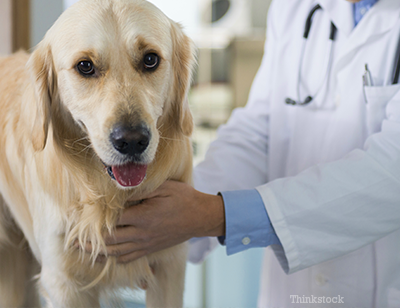AJ Debiasse, a technician in Stroudsburg, PA, contributed to this article.
When your dog has a mass (something unexpected in or on his body), one of the decisions you will need to make with your veterinarian is whether you should remove and test it, or test a piece of it first, and then remove it. Regardless of which option you choose, testing a piece of a mass is called a “biopsy.”  How is a biopsy performed?
How is a biopsy performed?
A biopsy is performed by removing a small portion of the mass and sending it to a pathologist. A veterinary pathologist is a veterinary specialist who reads microscopic preparations (cells or tissue on a slide). A few specialty practices, and all veterinary schools, have a pathologist on staff. Most other practices will send the samples to an outside lab. Depending on the sample and the lab, you will typically receive results an average of 7-10 days after the procedure. A biopsy is performed under sedation or general anesthesia in most cases. Small samples can sometimes be collected after local anesthesia is used, e.g., a skin biopsy.
Click here to learn about anesthesia safety and myths.
Why might your veterinarian suggest that a mass be removed after a biopsy?
Depending on the location of the mass, it may be challenging to safely remove (excise) it in its entirety.
If a microscopic examination reveals that the mass is cancerous (malignant), your veterinarian will want to remove as much of it as possible — even if it means removing healthy tissues beyond the mass (in every direction). This can be difficult, if not impossible, in some areas where there is little extra skin (such as the foot or the leg) but it will be very important to keep the cancer from spreading.
However, if the biopsy reveals that the mass is benign, then less healthy tissue needs to be removed. In this situation, the biopsy will change the invasiveness of the surgery.
Why might your veterinarian suggest that a mass be removed before a biopsy?
When a mass is small, it may not be much more invasive to remove it completely than to take a biopsy first. The smaller the mass, the easier it is to remove, meaning a less invasive surgery for your dog and a smaller bill for you.
Delaying treatment by performing a biopsy first is not always ideal either. Even if a mass is benign, if it's causing a blockage or mobility issues, it should be removed right away. In these cases, since a biopsy would not change the immediate treatment plan, it is reasonable, if not advisable, to go straight to surgery.
For very aggressive masses, actively bleeding masses or rapidly declining patients, delaying treatment is again not recommended. Waiting 7-10 days for biopsy results could make the difference between life and death, or could cause additional suffering. Performing a biopsy and then removing it also means that your dog will be undergoing anesthesia twice in a short period of time. If your dog is healthy, the risk is minimal. But if your dog is sick, your veterinarian may decide it’s safer to opt for removal without a preliminary biopsy to minimize the potential of anesthetic complications.
Performing a biopsy first and surgery later is also more costly. Click here to learn about pet insurance so that you are never put in a position where finances keep your pet from the best possible care.
Pet biopsy decision tips
- As with all medical decisions, discuss the pros and cons of each option with your veterinarian or surgeon to choose the best treatment plan for your particular dog. Ask questions, weigh your options and make sure you feel comfortable with your decision.
- If you want to have a mass removed completely, regardless of what it is (benign or malignant) there is no sense in performing a biopsy before the mass is removed
- If biopsy results will change your decision or will change the surgeon’s procedure, then a biopsy should be taken first
- Whether the biopsy is performed before or after surgery, it should always be performed so we know what the growth is. If it is cancerous, there may be other things we can do to help beyond surgery. If it is benign, then we can rejoice!
If your dog has a mass, ask your veterinarian the following questions:
- Should we perform a biopsy first?
- Is the biopsy going to change what we do?
- Can we afford to wait for the results of the biopsy?
If you have any questions or concerns, you should always visit or call your veterinarian -- they are your best resource to ensure the health and well-being of your pets.
